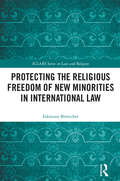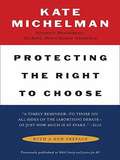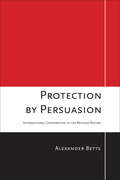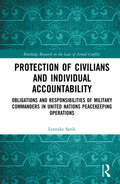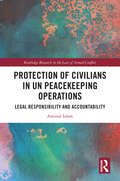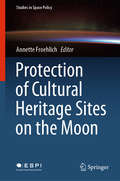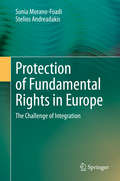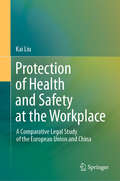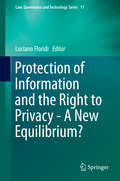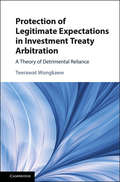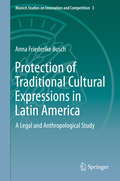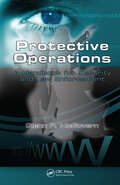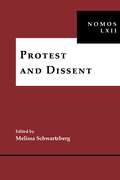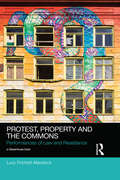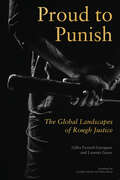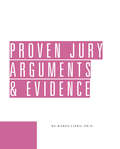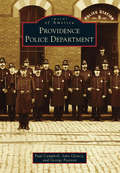- Table View
- List View
Protecting the Religious Freedom of New Minorities in International Law (ICLARS Series on Law and Religion)
by Fabienne BretscherThis book examines the interpretation and application of the right to freedom of religion and belief of new minorities formed by recent migration by the European Court of Human Rights (ECtHR) and the United Nations Human Rights Committee (HRC). New minorities are increasingly confronted with restrictions of their religious practices and have addressed their rights claims both to the ECtHR and the HRC through their individual complaint procedures, which resulted in several contradicting decisions. Based on a quantitative and qualitative empirical analysis of the relevant case law, focusing in particular on the reasoning adopted by the two bodies, this book finds that the HRC in its practice offers a significantly higher level of protection to new minorities than the ECtHR. Such divergence may be explained by various institutional and conceptual differences, of which the concept of the margin of appreciation is the most influential. It is contended that the extensive use of the concept of the margin of appreciation by the ECtHR in the case law regarding new minorities’ right to freedom of religion and belief, and the absence of such concept in the HRC’s case law, could be explained by different understandings of the role of an international human rights body in conflicts between the majority and minorities. This book argues that such divergence could be mitigated with various tools, such as the inclusion of cross-references to the case law of other relevant bodies as well as to instruments specifically established for the protection of minorities. The book will be of interest to academics, researchers and practitioners in the area of international human rights law, international public law in general and law and religion.
Protecting the Right to Choose
by Kate MichelmanFrom the former president of NARAL Pro-Choice America comes a politically impassioned, thought-provoking, and timely narrative about a woman's constitutional right to shape her own life. Catalyzed by a pre-Roe v. Wade abortion, which required the consent of the husband who left her and the approval of a hospital panel made up entirely of men, Kate Michelman-a seasoned lobbyist, skilled political strategist, and trusted advisor to some of the most powerful leaders in America-has since devoted her life to protecting the rights of women and children. As president of NARAL from 1985 to 2004, Michelman catapulted the organization to prominence as the nation's premier reproductive rights group, transforming the political debate and moving the question "Who decides?" to the mainstream. Now, in Protecting the Right to Choose, Michelman offers a from-the-front-lines historical perspective on the issue of choice, through the fascinating lens of her life and life's work.
Protecting the Rights of Women Migrant Domestic Workers: Structural Violence and Competing Interests in the Philippines and Sri Lanka (Routledge Series on Asian Migration)
by Sophie HendersonMigrant women across Asia disproportionately work in precarious, insecure, and informal employment sectors that are subject to few regulations, receive low pay, and expose women to harm, of which domestic work is among the most prevalent. This book uses the cases of the Philippines and Sri Lanka to develop a comprehensive, intersectional, rights-based approach to better protect women migrant domestic workers against exploitation. As accounts of exploitation, gender-based violence, torture, and death among migrant domestic workers increase, the recognition and defence of their human and labour rights is an urgent necessity. The Philippines and Sri Lanka are two of the leading labour-sending states of women domestic workers in Asia, and their economies have become increasingly dependent on the remittances they send back home. Drawing on extensive original research, this book argues that these two sending states are guilty of structural violence by sustaining a network of institutions, policies and practices which serve to systematically disadvantage and discriminate against women migrant domestic workers. The research covers the entire migration process, from pre-departure, through to overseas employment, followed by return and reintegration. This book’s innovative application of structural violence theory as a way to investigate the role of state institutions in labour-sending countries in the Global South will be of interest to researchers from across the fields of migration studies, gender studies, human rights law, and Asian Studies.
Protecting the Vulnerable: A Reanalysis of Our Social Responsibilities
by Robert E. GoodinIn this book, Robert E. Goodin speaks on our special responsibilities toward our families, friends, clients, compatriots, etc., that are relatively strong moral claims with restricted scope. He adds, vulnerability of the beneficiary rather than any voluntary commitment per se on the part of the benefactor which generates these special responsibilities and we should always strive to protect the vulnerable.
Protection Amid Chaos: The Creation of Property Rights in Palestinian Refugee Camps (Columbia Studies in Middle East Politics)
by Nadya HajjThe right to own property is something we generally take for granted. For refugees living in camps, in some cases for as long as generations, the link between citizenship and property ownership becomes strained. How do refugees protect these assets and preserve communal ties? How do they maintain a sense of identity and belonging within chaotic settings?Protection Amid Chaos follows people as they develop binding claims on assets and resources in challenging political and economic spaces. Focusing on Palestinians living in refugee camps in Lebanon and Jordan, it shows how the first to arrive developed flexible though legitimate property rights claims based on legal knowledge retained from their homeland, subsequently adapted to the restrictions of refugee life. As camps increased in complexity, refugees merged their informal institutions with the formal rules of political outsiders, devising a broader, stronger system for protecting their assets and culture from predation and state incorporation. For this book, Nadya Hajj conducted interviews with two hundred refugees. She consults memoirs, legal documents, and findings in the United Nations Relief Works Agency archives. Her work reveals the strategies Palestinian refugees have used to navigate their precarious conditions while under continuous assault and situates their struggle within the larger context of communities living in transitional spaces.
Protection and Promotion of Freedom of Religions and Beliefs in the European Context
by Luca Paladini Maria del Ángel Iglesias VázquezThis book offers an in-depth analysis of a fundamental human freedom and a cornerstone of democracy: the Freedom of Religions or Beliefs (FoRB). The book focuses on the legal protection and promotion of FoRB in Europe because, in this context, exercising this right goes beyond a mere internal positioning in terms of legislation; rather, it is influenced by international and supranational case law, as well as the promotional activities of selected non-state subjects of international law.The content is divided into three sections: Part I on the European Convention of Human Rights, Part II on the EU, and Part III on other international actors. The first two Parts examine FoRB in its systematic aspects and “day-to-day” aspects. In contrast, the third Part highlights the promotional activities carried out by the Holy See, the ILO, the Council of Europe (“beyond the Strasbourg Court”), and the OSCE to promote, recommend or otherwise support it. Overall, the volume highlights how the exercise of FoRB can be ensured via international and supranational legal protection (both normative and judicial) and via promotional activities aimed at encouraging and helping states guarantee tolerance and pluralism in their national legislation.The 16 main chapters offer a broad overview of the topic under investigation. Each contribution can be seen as a stand-alone study and, simultaneously, as a link in a chain of legal analysis that connects multiple FoRB-focused questions.The book offers a valuable tool for all readers with an academic or professional interest in FoRB and those who have to address the issue of how to protect this freedom. It is intended not only for academics who work in the field of law but also for legal practitioners (judges, lawyers, diplomats), human rights advocates, members of religious and spiritual communities, policymakers and students.
Protection by Persuasion: International Cooperation in the Refugee Regime
by Alexander BettsStates located near crisis zones are most likely to see an influx of people fleeing from manmade disasters; African states, for instance, are forced to accommodate and adjust to refugees more often than do European states far away from sites of upheaval. Geography dictates that states least able to pay the costs associated with refugees are those most likely to have them cross their borders. Therefore, refugee protection has historically been characterized by a North-South impasse. While Southern states have had to open their borders to refugees fleeing conflict or human rights abuses in neighboring states, Northern states have had little obligation or incentive to contribute to protecting refugees in the South.In recent years, however, the Office of the United Nations High Commissioner for Refugees (UNHCR) has sought to foster greater international cooperation within the global refugee regime through special conferences at which Northern states are pushed to contribute to the costs of protection for refugees in the South. These initiatives, Alexander Betts finds in Protection by Persuasion, can overcome the North-South impasse and lead to significant cooperation. Betts shows that Northern states will contribute to such efforts when they recognize a substantive relationship between refugee protection in the South and their own interests in such issues as security, immigration, and trade. Highlighting the mechanisms through which UNHCR has been able to persuade Northern states that such links exist, Protection by Persuasion makes clear that refugee protection is a global concern, most effectively addressed when geographic realities are overridden by the perception of interdependence.
Protection of Civilians and Individual Accountability: Obligations and Responsibilities of Military Commanders in United Nations Peacekeeping Operations (Routledge Research in the Law of Armed Conflict)
by Lenneke SprikThis book explores the question of whether peacekeeping commanders can be held accountable for a failure to protect the civilian population in the mission area. This requires an assessment of whether peacekeeping commanders have an obligation to act against such serious crimes being committed under domestic and international law. The work uses the cases of the Dutch and Belgian peacekeeping commanders in Srebrenica and Kigali as examples, but it also places the analysis into the context of contemporary peacekeeping operations. It unfolds two main arguments. First, it provides a critical note to the contextual interpretation given to international law in relation to peacekeeping. It is argued that establishing a specific paradigm for peacekeeping operations with clear rules of interpretation and benchmark criteria would benefit peacekeeping and international law by making the contextual interpretation of international law redundant. Second, it is held that alternative options to the existing forms of criminal responsibility for military commanders should be considered, possibly focusing more clearly on failing to fulfil a norm of protection that is specific to peacekeeping and distinct from protective obligations under international human rights law and international humanitarian law.
Protection of Civilians in UN Peacekeeping Operations: Legal Responsibility and Accountability (Routledge Research in the Law of Armed Conflict)
by Aminul IslamThis book discusses the legal responsibility of UN peacekeepers for the protection of civilians under international legal regimes, particularly international human rights law, international humanitarian law, international refugee law, and occupation law. It considers both negative and positive obligations, that is, a duty to respect or not violate a particular right directly and a duty to take positive action to secure or protect a particular right, respectively. In addition, it describes the standards and methods, as well as their strengths and weaknesses, by which actors in UN peacekeeping operations, including the UN, troop contributing countries, and individual peacekeepers, can be held accountable for third-party claims and allegations of criminal misconduct against UN peacekeepers for violations of responsibility in peacekeeping operations. The work will be a valuable resource for academics, researchers, and policy-makers working in the areas of International Law, International Humanitarian Law, International Human Rights Law, and International Relations.
Protection of Cultural Heritage Sites on the Moon (Studies in Space Policy #24)
by Annette FroehlichThis book provides an extensive overview of the protection of cultural heritages sites on the Moon (humanity’s lunar heritage) and the various threats they face. First of all, the international legal framework, especially the relevant space treaties are analyzed in terms of how they protect cultural heritages sites on the Moon. In turn, the book explores key aspects like the application of customary law, the UNESCO World Heritage Convention, or the Underwater Convention, and the possibility of adding these sites to UNESCO’s World Heritage list. The book subsequently addresses the question of how to define culture heritage sites or artifacts, in particular in view of the “Outstanding Universal Value” criterion, which is a vital aspect in order to differentiate them from space garbage or even space threats. Lastly, the book proposes and elaborates on various protection systems and multilateral protection regulations. Especially now, 50 years after the first human landing on the Moon, the book is a timely publication that will be of interest to all scholars and professionals working in the space field.
Protection of Fundamental Rights in Europe: The Challenge of Integration
by Sonia Morano-Foadi Stelios AndreadakisThis monograph offers a longitudinal analysis of the developments in the European fundamental rights arena during the last decade. Decisions of critical importance on the future of the EU need to be taken by the EU institutions and the Member States' governments. The ‘existential’ crisis affecting Europe is essentially a crisis of values revealing a lack of shared vision. Based on this premise, this monograph contributes to the debate on how to overcome the current impasse. By situating the analysis of the EU in the context of a wider Europe, which includes the ECHR (and its interpretation by the ECtHR), this work challenges the idea that the project of European integration should be abandoned. Instead it proposes a re-orientation of this process, conceptualised as a dynamic interaction of different actors, sources and laws on fundamental rights within the wider Europe. Following an evaluation of the current fundamental rights’ regimes, the monograph proposes a model of effective governance of fundamental rights in Europe based on the doctrines of dialogical constitutionalism and agency. This original and innovative contribution is enriched by findings from British Academy funded research on the European architecture of fundamental rights post-Lisbon Treaty.
Protection of Health and Safety at the Workplace: A Comparative Legal Study of the European Union and China
by Kai LiuThis book investigates four core characteristics of occupational health and safety legal systems in order to provide a comparative and critical analysis of the similarities and differences in protecting the health and safety of workers at the workplace. In addition to analysing the health and safety regulations, the book addresses corresponding oversight and enforcement mechanisms. It compares and contrasts five different legal systems, namely those of the EU, the Netherlands, the UK, Sweden and China. Beyond offering an overview of the modes of OHS regulation, instruments and legal enforcement practices, the book helps to answer the question of how to improve working environments in order to protect workers from all kinds of dangers encountered at the workplace. The intended readership includes researchers with a background in labour law, comparative law, Chinese law and/or European Union law.
Protection of Human Life at Sea in International Law: Rescuing Maritime Migrants (Law and Migration)
by Aphrodite PapachristodoulouThe law of the sea imposes a long-established duty to rescue persons in distress, which connotes one of the most important tools in safeguarding safety of life at sea. Other rules of international law, namely, international human rights and refugee law also come into play in drawing the legal parameters for the conduct of rescue operations.Amid the thousands of people undertaking perilous sea journeys in search of safety, European legal responses have primarily focused on the securitization of migration. This book exposes the human rights violations that may be perpetrated against migrants attempting to cross the Mediterranean and strongly advocates for the development of a framework for operationalizing the protection of human rights – and life – at sea. It combines theory and practice in which philosophical theories of rights are applied to create a framework for legal analysis and the development of practical legal standards. The study presents an innovative evaluation of selected judgments of the European Court of Human Rights and other international human rights bodies pertaining to complex questions of extraterritorial jurisdiction and a State's human rights obligations towards persons in distress at sea.The book will be of interest to all those engaging with migration and security studies, international human rights scholarship, international law of the sea, refugee and migration law and legal philosophy, whether generalist or specialist.
Protection of Information and the Right to Privacy - A New Equilibrium?
by Luciano FloridiThis book presents the latest research on the challenges and solutions affecting the equilibrium between freedom of speech, freedom of information, information security and the right to informational privacy. Given the complexity of the topics addressed, the book shows how old legal and ethical frameworks may need to be not only updated, but also supplemented and complemented by new conceptual solutions. Neither a conservative attitude ("more of the same") nor a revolutionary zeal ("never seen before") is likely to lead to satisfactory solutions. Instead, more reflection and better conceptual design are needed, not least to harmonise different perspectives and legal frameworks internationally. The focus of the book is on how we may reconcile high levels of information security with robust degrees of informational privacy, also in connection with recent challenges presented by phenomena such as "big data" and security scandals, as well as new legislation initiatives, such as those concerning "the right to be forgotten" and the use of personal data in biomedical research. The book seeks to offer analyses and solutions of the new tensions, in order to build a fair, shareable and sustainable balance in this vital area of human interactions.
Protection of Legitimate Expectations in Investment Treaty Arbitration: A Theory of Detrimental Reliance
by Teerawat WongkaewThis book evaluates the core of the concept of legitimate expectations from first principles in moral philosophy. It adopts an unconventional approach by examining this topic from a deep, philosophical perspective and delves into the debates on the binding nature of promise in moral philosophy. It then develops a doctrinal structure for the standard of protection. The author places the key premise of the book on the possibility of deriving firm conclusions from the debate and on creating a set of precise and prescriptive 'guidelines of the application of legitimate expectations'. The features of this book are threefold: first, a significant body of literature on moral philosophy is assimilated; second, core philosophical principles are extracted and expressed as a normative framework to resolve concrete cases; third, the author analysed a vast number of investment treaty awards against the underlying framework.
Protection of Traditional Cultural Expressions in Latin America
by Anna Friederike BuschThis book analyses the topic of protecting traditional cultural expressions (TCEs) in Latin America. It questions classic legal approaches and involves the interface of anthropology and law. The study analyses regional, national and local particularities of law on paper and law in reality. It includes personal fieldwork research in selected countries and puts light on the political, socio-economic and environmental dimension of the topic. Based upon these insights, the study gives recommendations for a more enhanced, interdisciplinary understanding and protection of TCEs. Latin America is (still) rich of cultural traditions and bio- and sociodiversity. This region is the cradle of the international discussion on protecting TCEs. The national situations are diverse and allow conclusive comparisons. Some countries have established concrete protection systems, like Panama, and made useful experiences. It is time to resume: What do TCEs really mean? Should they be protected by law and if so, how? What can we learn from the practical experiences made so far? The following is clear: The true test for any new legislation - in Latin America and elsewhere - is its impact on the everyday life.
Protection of the Environment under International Law during Occupation: International Humanitarian, Human Rights and Environmental Law (Routledge Research in International Environmental Law)
by Waad AbualrobThis book examines the relationship between International Environmental Law and Human Rights Law regarding the protection of the environment in times of occupation.Times of occupation create a tangible threat to the environment, alongside human, animal, and plant rights. This book uses international law to grapple with unprecedented environmental challenges, from water, air and soil pollution and severe damage to natural resources to the complexities of regulating emerging environmental challenges during extraordinary situations. Using international case studies alongside the prominent and evolving role of international law agreements, in particular Multilateral Environmental Agreements (MEAs), this book offers a comprehensive analysis of the legal tools available to navigate environmental challenges under occupation. The book also discusses occupying power obligations under public international law and the demands of protecting the environment in occupied territory.The book provides a valuable resource for researchers in the field of environmental law, human rights law, and humanitarian law.
Protective Operations: A Handbook for Security and Law Enforcement
by Glenn McGovernA reference for law enforcement and security organizations tasked with protecting the welfare of an individual or groups of individuals, this volume offers suggestions and guidance for confronting high-threat scenarios as well as the more mundane protective details. Detailing the essence of protective operations that are run, in large part, covertly, the book explores operational security, situational awareness, and surveillance detection and includes examples from real-world attacks occurring over the past sixty years. Focusing on the economics of providing the most protection for the least cost, it also addresses issues surrounding possible direct violations of the law and department policy and procedures.
Protective Services
by Joyce LibalNot every child is lucky enough to live in a safe, loving home. Many young people live in difficult, unhealthy, or even dangerous conditions. Luckily, there are systems in place to help kids caught in theses situations. Child protective services are working hard to help children in need. Ryan Delaney is one of these kids. He spends most of his time living in a fantasy world, because that's easier than facing his real life. He lies to his friends about his parents and his home--but eventually, the truth catches up with him, forcing him to get the help he needs. As you read Ryan's story, you will learn about the history of the child protective services and find out about the programs and services offered today.
Protest and Dissent: NOMOS LXII (NOMOS - American Society for Political and Legal Philosophy #3)
by Melissa SchwartzbergEssays on the justification, strategy, and limits of mass protests and political dissent In Protest and Dissent, the latest installment of the NOMOS series, distinguished scholars from the fields of political science, law, and philosophy provide a fresh, interdisciplinary perspective on the potential—and limits—of mass protest and disobedience in today’s age. Featuring ten timely essays, the contributors address a number of contemporary movements, from Black Lives Matter and the Women’s March, to Occupy Wall Street and Standing Rock. Ultimately, this volume challenges us to re-imagine the boundaries between civil and uncivil disagreement, political reform and radical transformation, and democratic ends and means. Protest and Dissent offers thought-provoking insights into a new era of political resistance.
Protest, Property and the Commons: Performances of Law and Resistance (Social Justice)
by Lucy Finchett-MaddockProtest, Property and the Commons focuses on the alternative property narratives of ‘social centres’, or political squats, and how the spaces and their communities create their own – resistant – form of law. Drawing on critical legal theory, legal pluralism, legal geography, poststructuralism and new materialism, the book considers how protest movements both use state law and create new, more informal, legalities in order to forge a practice of resistance. Invaluable for anyone working within the area of informal property in land, commons, protest and adverse possession, this book offers a ground-breaking account of the integral role of time, space and performance in the instituting processes of law and resistance.
Protracted Displacement in Asia: No Place to Call Home (Law, Ethics And Governance Ser.)
by Howard AdelmanIn a protracted displacement situation, refugees are sequestered in camps without right of mobility or employment; their lives remain on hold and stagnate in a state of limbo for a long period. This book reviews the situation and results of research and policies that have left refugees as a forgotten group in protracted situations. The work features case studies by experts who conducted field work examining long-term protracted refugee situations in Nepal, Thailand and Bangladesh, the protracted internally displaced (IDP) situation in Sri Lanka, and the refugee and IDP situation in Afghanistan. Also discussed is an emerging protracted refugee and IDP problem in Iraq. The volume concludes with an analysis of the lessons learned and the applications for policy, and incorporates a valuable bibliography detailing research in this hugely important area. This is a critical resource for academics and policy makers concerned with migration and governance issues.
Proud to Punish: The Global Landscapes of Rough Justice
by Gilles Gayer Laurent GayerA magisterial comparative study, Proud to Punish recenters our understanding of modern punishment through a sweeping analysis of the global phenomenon of "rough justice": the use of force to settle accounts and enforce legal and moral norms outside the formal framework of the law. While taking many forms, including vigilantism, lynch mobs, people's courts, and death squads, all seekers of rough justice thrive on the deliberate blurring of lines between law enforcers and troublemakers. Digital networks have provided a profitable arena for vigilantes, who use social media to build a following and publicize their work, as they debase the bodies of the accused for purposes of edification and entertainment. It is this unabashed pride to punish, and the new punitive celebrations that actualize, publicize, and commercialize it, that this book brings into focus. Recounted in lively prose, Proud to Punish is both a global map of rough justice today and an insight into the deeper nature of punishment as a social and political phenomenon.
Proven Jury Arguments & Evidence
by Karen LiskoProven Jury Arguments & Evidence Dr. Karen Lisko has observed the deliberations of hundreds of mock juries in over 25 years of helping attorneys develop case strategies. She has also conducted scores of post-trial interviews with actual jurors. Her research findings have been compiled in Proven Jury Arguments & Evidence. This helpful book provides general recommendations for persuading all types of juries, and offers detailed advice for the following 9 types of cases: Negligence * Auto accidents * Police misconduct * Slips and falls * Medical malpractice * Products liability Business * Breach of business supply contract * Breach/delay of construction contract Employment * Race discrimination * Sexual harassment Learn about jury biases and key questions, what case elements juries find persuasive, potential winning case themes, effective case analogies, most important witnesses, rules of thumb for arguing damages, high-risk juror profiles, and pattern voir dire questions--all specific to case type and plaintiff or defendant.
Providence Police Department (Images of America)
by George Pearson Paul Campbell John GlancyThe Providence Police Department has served New England's second-largest city from its beginnings in 1651 with the appointment of a town sergeant to today's force of nearly 500 men and women. Officially established in 1864, policing in Providence has changed considerably from the days of night watchmen armed with handheld rattle alarms and nightsticks. Whether quelling the violent street riots of 1914, enforcing Prohibition, or fighting the New England mob, the PPD has evolved to meet the complex challenges posed by the city. It also boasts a history of leadership among the nation's law enforcement agencies, being among the first to incorporate women into the department's ranks, create innovative campaigns to reduce traffic fatalities, and pioneer the use of trained canines to aid in police work. Today, cutting-edge telecommunications and forensic analysis in crime fighting continue to protect the city of nearly 178,000.
